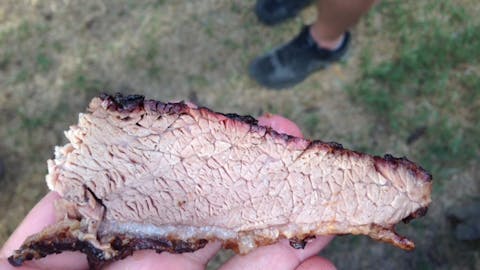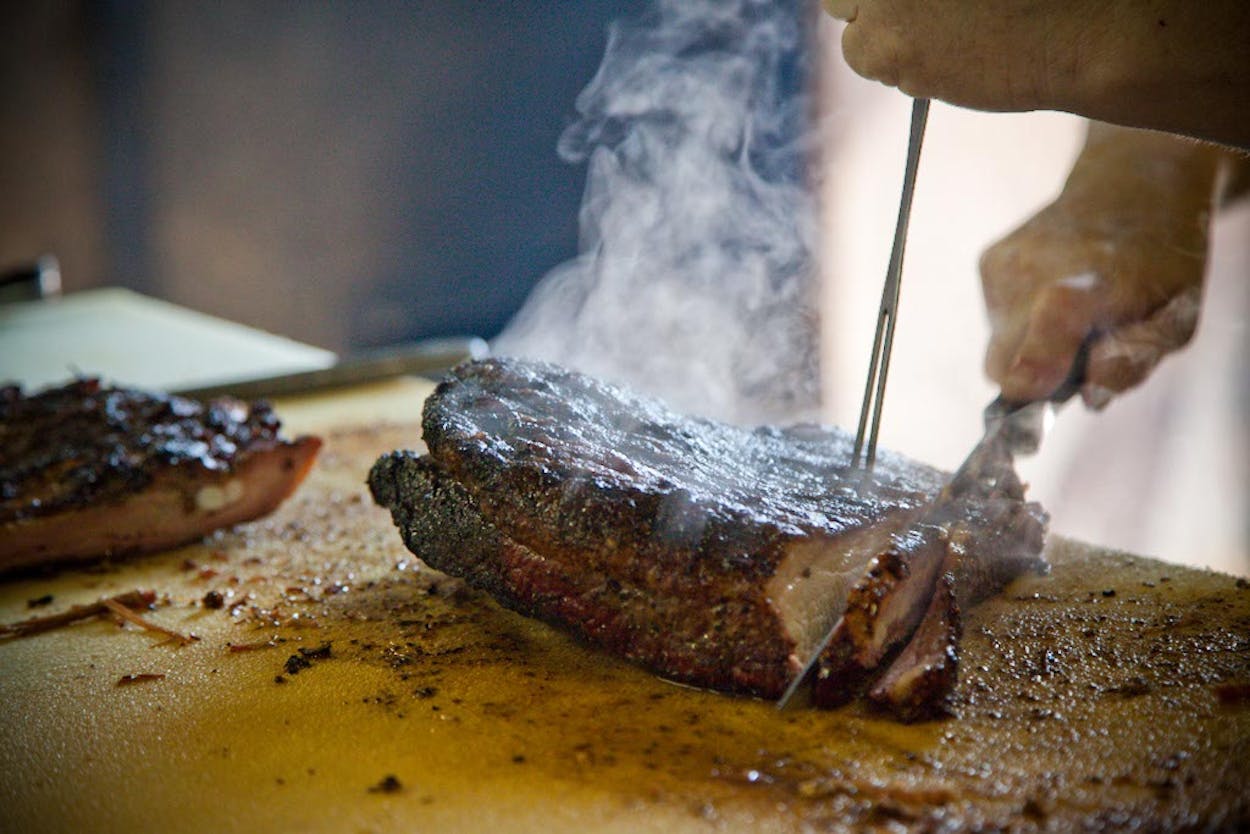Patience. Not only is it a virtue, it’s the key to good brisket. No meat in barbecue suffers more when it’s subjected to the foolish habits of the impatient pitmaster: cranking the heat too high in the smoker; obsessively opening and closing the lid to check on the smoker’s contents; or just taking the meat off the fire too early. Those actions can all undo the promise of a good hunk of smoked meat, but the most frustrating mistake to witness is when someone slices into the damned thing too early. Re-education can remedy most problems, but learning when to slice requires a sense of time management during the cooking process.
Take it from a brisket master. In the chapter on brisket in Aaron Franklin’s forthcoming book, he notes the importance of resting. “To cut it open right after it’s been pulled is literally to lose a lot of important liquid, and you could see a great brisket dry up in no time after hours of meticulous cooking.” Franklin rests his briskets for several hours before holding them just above the temperature required by the health department.
The notion of resting meat is probably well known to anyone who spends enough time watching the Food Network. This practice is a common final step in recipes that involve meat cooked over high heat, and most people believe that a finished steak or roasted chicken should sit for several minutes before being carved so the juices can redistribute. But that’s not exactly how it works. As Modernist Cuisine describes it, “Degraded and dissolved proteins slightly thicken the natural juices as they cool during resting. The thickened liquid then escapes more slowly when the meat is sliced.” But the liquid that drains out can be recovered. What’s lost forever is the steam.
Let’s observe the cutting area of an anonymous barbecue joint (pictured above). The carver places a smoked brisket on the butcher block to be sliced. It’s hot from the pit, and the steam rises from its surface. A greater puff of steam arises once the knife slices through the meat and each slab of brisket on the board continues to percolate. Your mouth is watering, and it better be. You’re going to need all the saliva you can muster to choke down the dry shoe leather that’ll end up as your dinner. This is meat that hasn’t been rested.

What you witnessed is accelerated evaporation, and from middle school science class you remember that evaporation is a cooling process. The interior of a well cooked brisket temps in at around two hundred degrees. That’s not a comfortable eating temperature. Can you remember a great slice of brisket that burnt your fingers? Probably not. You want the meat to cool, but you want that to happen slowly as explained in Modernist Cuisine. “Resting also allows the steep temperature gradient inside the meat to come closer to equilibrium.” Even after the surface has cooled (this happens almost immediately after taking a steak off the grill), the interior of the meat is still piping hot.
To clarify, resting is not synonymous with the practice of “holding,” or keeping the meat at a certain temperature over time. Using your beer cooler at home as a “Faux Cambro” will keep the meat hot for hours, but don’t consider it resting. Resting needs to happen in the open air. Think about the difference between thawing frozen meat in the refrigerator versus the counter. Both will the thaw the meat eventually, but resting meat is like placing it on the counter. You get to your desired internal temperature much more rapidly.
Food scientist Greg Blonder set out to debunk the importance of resting meat on his blog genuineideas. After multiple experiments with pork loins and ribeyes, he concluded that resting doesn’t matter much as long as you can capture the lost juices and pour it back over the sliced meat. That’s not much of a possibility when the cutting board is in the restaurant’s kitchen or on the other side of busy lunch counter, as is the case for most barbecue joints.
Blonder’s experiments sounds as though it runs counter to what I just wrote, but one needs to consider what cut of meat they’re resting. Adam Perry Lang, a chef, pitmaster, and certified meat geek, agrees with Blonder that the thinner cuts can be salvaged when they’re cut right off of the grill, but Lang preaches the importance of resting larger, collagen-rich cuts like brisket. “That rest is so crucial to allow that collagen to become gelatin. Think of it as Jell-o. Jell-o that’s too hot is liquid, and it just pisses out of the meat.” With just a little patience and a good rest, your brisket can hold onto all that good gelatin, instead of watching it disappear into the air and leaving a puddle on your cutting board.








